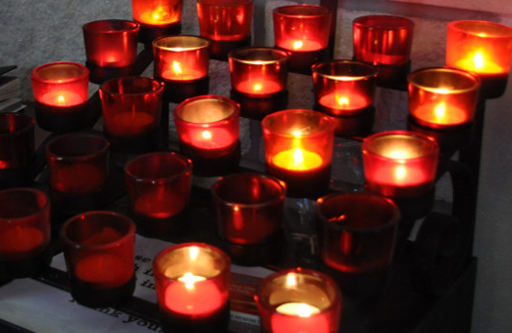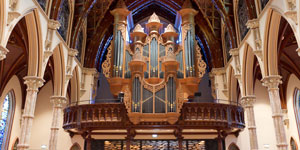Evangelization Programs
Filling Your Spiritual Backpack
Celebrating St. Francis Xavier Cabrini’s Birthday: Sunday, July 14 at 1:30pm
The youngest of thirteen children, Frances Cabrini was born on July 15, 1850 in a small village called S’ant Angelo Lodigiano near the city of Milan, Italy. Little did she know that she would become Chicago’s own Catholic saint. We gather on the eve of her birthday to learn of her journeys in Chicago, and beyond. We conclude with singing “Happy Birthday” at her statue. And yes, there will be cake!.
Florence Sorensen, parishioner and longtime disciple of Mother Cabrini, will lead our discussion. She will share her personal experience of the Missionary Sisters of the Sacred Heart of Jesus at Columbus Hospital. We meet at 1:30, Sunday, July 14, in the clubroom.
Caminos Del Santo Nombre
What are Los Caminos del Santo Nombre?
The concept of Los Camino del Santo Nombre began from the experience of a parishioner who traveled the Camino de Santiago in Spain. The experience was a part of his decision to become Catholic. After many conversations, he and Dr. Ortega created “small caminos” or pilgrimages throughout Chicago. The goal is give secular spaces, objects, and places a personal sacred experience.
The underlying objective is to accompany persons in their faith journeys, listening to their thoughts, and gently integrate the Good News in the discussion. The Evangelization Pillar of Holy Name Cathedral sponsors this initiative. Your contributions to Holy Name Cathedral allows us to offer these unique initiatives. Please continue to support our parish!
For more information, contact Kenneth E. Ortega, Ed.D., Director of Evangelization, kortega@holynamecathedral.org
Peligrino Kit. Each peligrino (pilgrim) is given a kit for the journey.
The Stone, a symbol of pilgrimage
Tradition dictates that walkers bring a stone from home or pick one up on their journey, which they leave at the cross. This act symbolizes the release of personal burdens, sins, or challenges, marking a moment of introspection and redemption. The Stone a sign of burdens left behind.
The Scallop Shell, a symbol of pilgrimage
There are many legends concerning the association of the scallop shell and St. James the Greater (it appears on mile-markers through Spain, representing the way to the Cathedral in Santiago). For our purposes, consider how the grooves in the shell lead to the center destination, the many paths that lead us to the Holy Name of Jesus.
Prayer of the Pilgrimages, Caminos of the Holy Name
Buen Camino! O, God, who brought your servant Abraham out of the land of Chaldean, protecting him in his wandering, who guided the Hebrew people across the desert, we ask that you watch over us, your servants, as we walk in the love of the Holy Name of Jesus.
Camino de los Animales de la Biblia (Animals of the Bible)
Saturday, May 18, 2024, 10 a.m. Lincoln Park Zoo
We may possibly learn new things about animals in the Bible as we roam the confines of Lincoln Park Zoo. Learn the details of the plague of frogs, the talking donkey, the symbols of the four Evangelists, and other animals that we sometimes dismiss when we hear the Scriptures.
Camino del lago (Lake Michigan) Saturday, July 20, 2024, 10 a.m., Navy Pier
Join us for an aquatic dive into the Scriptures. Integrating attractions at Navy Pier, Olive Park, and other lakefront paths, pelegrinos reflect on biblical references to water: Noah and Flood, Jonah and Whale, Parting of the Red Sea, John’s baptism, Jesus’ call to the disciples, and Jesus walking on the water.
Camino de los peuntes del rio (Bridges of the Chicago River) Saturday, September 21, 5 p.m., Assumption Parish
Within two miles there are 18 bridges in downtown Chicago. Join us as we spiritually 14 bridges into the 14 Stations of the Cross. Gathering at Assumption Parish, the Grand Avenue bridge becomes the first station of our Via Crucis, commemorating the death and passion of Jesus. We finish at the Centennial Fountain, near Columbus Drive, for a memorable conclusion. This camino, at dusk, offers a spiritual journey amid the lights of Chicago.
Camino de los muertos (Day of the Dead) November 16, 10 a.m., Graceland Cemetery
Convening at the site of the first Camino del Santo Nombre, we commemorate the morning to those who have died. The Way of the Dead is an extraordinary walk among graves and monuments, but we also encounter the flora and fauna of this heavily landscaped space. Pelligrinos will participate in prayers, Scripture, and an All Souls Novena on Daniel Burnham’s burial island.
Camino de la navidad (Way to the Nativity) Thursday, December 5, 5:30 p.m. Art Institute
Prepare Ye the way of the Lord! Pelligrinos can revere religious works of art dedicated to the Nativity of the Lord. We may also transfer spiritual meaning unto secular masterpieces. For us, the secular becomes sacred.
Rosary in the Courtyard
ROSARY IN THE COURTYARD
The Evangelization Pillar hosts the recitation of the rosary on the Marian celebrations during summer and autumn 2024. We meet in the Holy Name Cathedral courtyard, 6 p.m. Enter through the Wabash entrance.
Visitation between Mary and Elizabeth, May 31*, Friday
After the Archangel Gabriel leaves, Mary hastens to visit and help Elizabeth. Inspired by God, Elizabeth greets Mary for the first time as the mother of God with the words “Blessed is the fruit of thy womb Jesus.” John the Baptist leaps for joy in the womb of his mother, sanctified by the grace of the Divine Redeemer. Mary responds with the Magnificat. Tradition holds that Mary stayed with Elizabeth for three months, until the birth of her son or even until his circumcision.
Immaculate Heart of Mary, June 8, Saturday
Most Holy Virgin Mary, tender Mother of men, to fulfill the desires of the Sacred Heart of Jesus and the request of the Vicar of Your Son on earth, we consecrate ourselves and our families to your Sorrowful and Immaculate Heart, O Queen of the Most Holy Rosary, and we recommend to You, all the people of our country and all the world. Pope Pius XII
Our Mother of Perpetual Help, June 27, Thursday
The tradition of Our Mother of Perpetual Help is traced back to 1495. Stolen from a Cretan monastery by a wine merchant a few years after its creation, it was brought to the church of St. Matthew in Rome. For 300 years, it resided at the church, and even survived the church’s destruction by Napoleon’s army in 1798. Eighty-eight years later, Pope Pius IX gave the icon to the Redemptorist congregation at the Church of Saint Alphonsus, where it remains today. https://www.nationalshrine.org/blog/the-tradition-of-our-mother-of-perpetual-help/
Our Lady of Mt. Carmel, July 16 *, Thursday
On this day, in 1251, Our Lady appeared to St. Simon Stock, Carmelite, in Cambridge England and presented to him the Brown Scapular. Mary assured him that all who were invested and wore it with love would be saved from final damnation. This does not mean that a person can go about sinning with impunity simply because they wear the Scapular. The Scapular, it is said, should be worn around the heart. Our Lady once revealed to St. Dominic that she would convert the world through the Rosary and the Scapular.
Assumption of Mary, August 15*, Thursday
This celebration originated in the 5th or 6th Century. St. Juvenal of Jerusalem stated as early as the Council of Chalcedon in 451 that Our Lady, after her death, was assumed body and soul into heaven. Pope Pius XII, on 1 November 1950, in Munificentissimus Deus officially defined the doctrine of the Assumption as an article of the Catholic Faith.
Queenship of Mary, August 22*, Thursday
`Pope Pius XII in Ad Coeli Reginam proposed the traditional doctrine on the Queenship of Mary and established this feast for the Universal Church. Fittingly the Solemnity of the Assumption is now prolonged in the celebration of the Queenship of Mary, which occurs seven days after the Assumption (Marialis Cultus #6 at 18).
Birth of Mary, September 8*, Sunday
The feast of Our Lady’s birth originated in Syria or Palestine at the beginning of the 6th Century. The feast was introduced in Rome some 100 years later. Our Lady’s birthday has been described as “the hope of the entire world and the dawn of salvation” (Marialis Cultus #7 at 7 quoting the Roman Missal, 8 September, Prayer after communion).
Our Lady of Sorrows, September 15*, Sunday
This is the feast in honor of Mary’s seven sorrows. The seven sorrows (or seven dolors) are: Simeon’s Prophecy, the flight into Egypt, the loss of Jesus in the Temple, Mary’s meeting with Jesus on his way to Calvary, Jesus’s crucifixion, Mary receiving the dead body of Jesus and Jesus’s burial.
Our Lady of the Rosary, October 7 *, Monday
Pope Pius V started the Feast of the Most Holy Rosary (also known as the Feast of Our Lady of Victories) as an act of thanksgiving for Mary’s in the great naval victory over the Turks, in 1572. The feast was extended to the Universal Church in 1716, when Prince Eugene won another important victory over the same enemy in Hungary.
*https://www.ewtn.com/catholicism/library/marian-feasts-in-the-roman-calendar-11127


